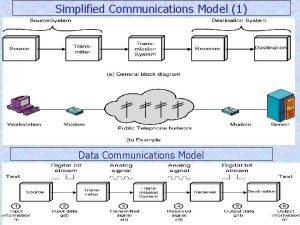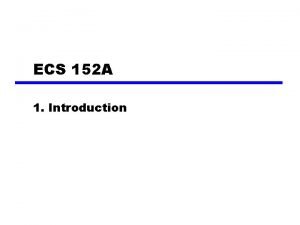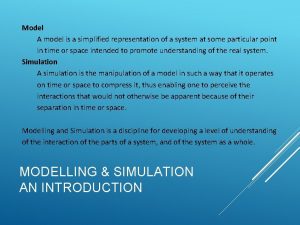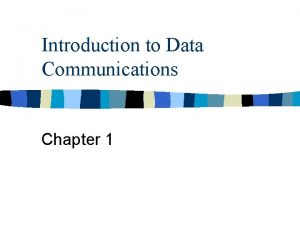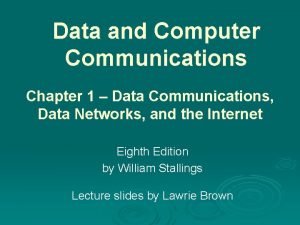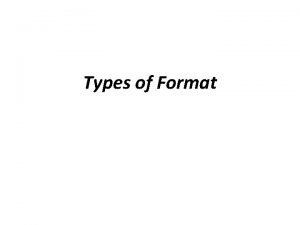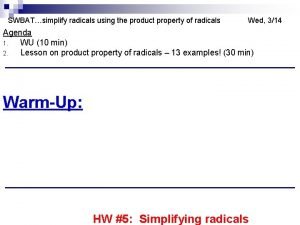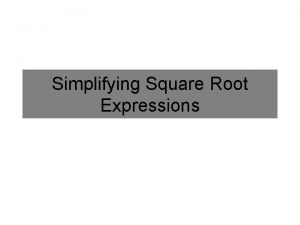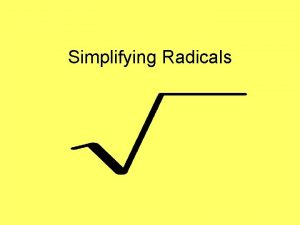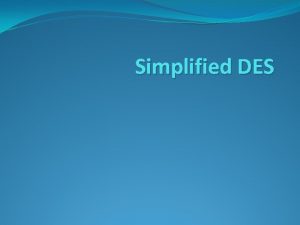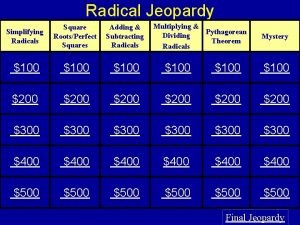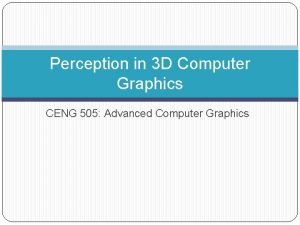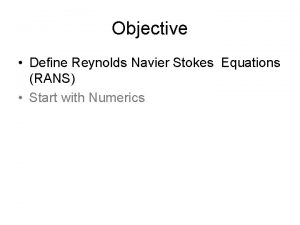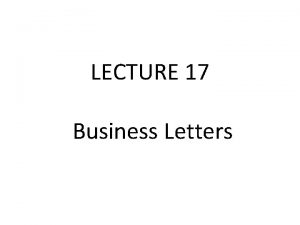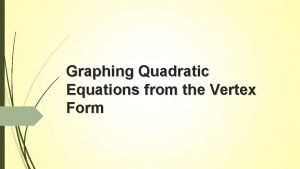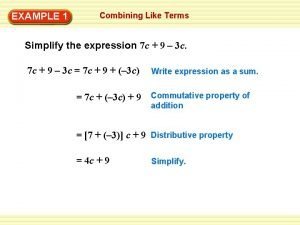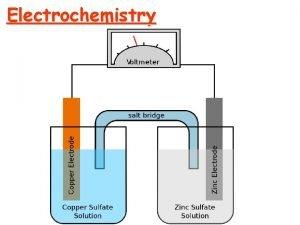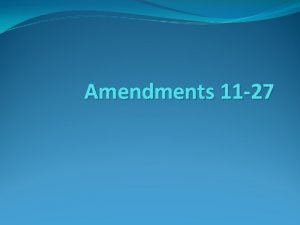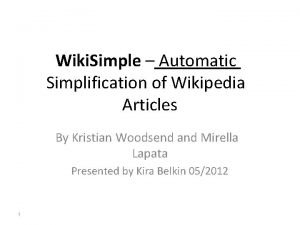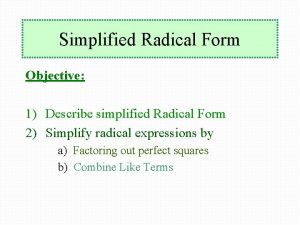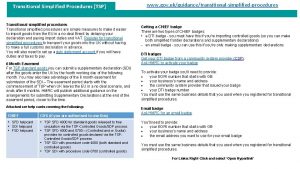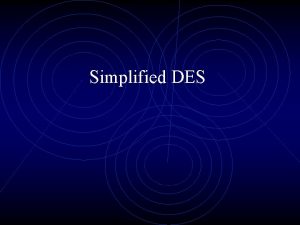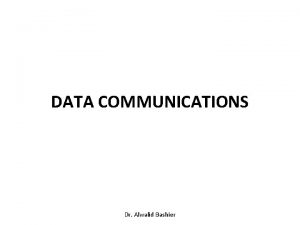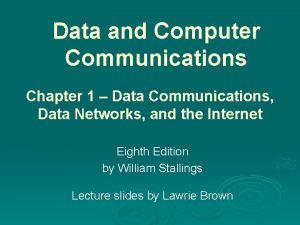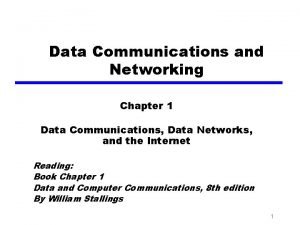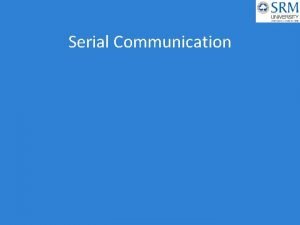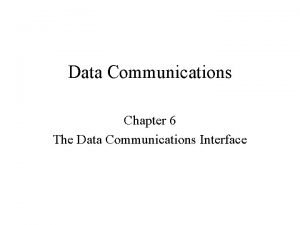Simplified Communications Model 1 Data Communications Model 3














































- Slides: 46

Simplified Communications Model (1) Data Communications Model 3. 1

Simplified Communications Model (2) n n n 3. 2 Source n generates data to be transmitted Transmitter n converts data into transmittable signals Transmission System n carries data Receiver n converts received signal into data Destination n takes incoming data from the receiver

3 -1 ANALOG AND DIGITAL Data can be analog or digital. The term analog data refers to information that is continuous; digital data refers to information that has discrete states. Analog data take on continuous values. Digital data take on discrete values. Topics discussed in this section: Analog and Digital Data; Analog and Digital Signals; Periodic and Nonperiodic Signals To be transmitted, data must be transformed to electromagnetic signals. Data can be analog or digital. Analog data are continuous and take continuous values. Digital data have discrete states and take discrete values. Signals can be analog or digital. Analog signals can have an infinite number of values in a range; digital signals can have only a limited number of values. In data communications, we commonly use periodic analog signals and nonperiodic digital signals. 3. 3

3 -2 PERIODIC ANALOG SIGNALS Periodic analog signals can be classified as simple or composite. A simple periodic analog signal, a sine wave, cannot be decomposed into simpler signals. A composite periodic analog signal is composed of multiple sine waves. Topics discussed in this section: Sine Wave; Wavelength; Time and Frequency Domain; Composite Signals; Bandwidth Figure 3. 2 A sine wave Example 3. 1 The power in your house can be represented by a sine wave with a peak amplitude of 155 to 170 V. However, it is common knowledge that the voltage of the power in U. S. homes is 110 to 120 V. This discrepancy is due to the fact that these are root mean square (rms) values. The signal is squared and then the average amplitude is calculated. The peak value is equal to 2½ × rms value. 3. 4

Figure 3. 3 Two signals with the same phase and frequency, but different amplitudes Example 3. 2 The voltage of a battery is a constant; this constant value can be considered a sine wave, as we will see later. For example, the peak value of an AA battery is normally 1. 5 V. Frequency and period are the inverse of each other. Figure 3. 4 Two signals with the same amplitude and phase, but different frequencies Table 3. 1 Units of period and frequency 3. 5

Example 3. 3 The power we use at home has a frequency of 60 Hz. The period of this sine wave can be determined as follows: Example 3. 4 Express a period of 100 ms in microseconds. Solution From Table 3. 1 we find the equivalents of 1 ms (1 ms is 10− 3 s) and 1 s (1 s is 106 μs). We make the following substitutions: . Example 3. 5 The period of a signal is 100 ms. What is its frequency in kilohertz? Solution First we change 100 ms to seconds, and then we calculate the frequency from the period (1 Hz = 10− 3 k. Hz). 3. 6

Frequency is the rate of change with respect to time. Change in a short span of time means high frequency. Change over a long span of time means low frequency. If a signal does not change at all, its frequency is zero. If a signal changes instantaneously, its frequency is infinite. Phase describes the position of the waveform relative to time 0. Figure 3. 5 Three sine waves with the same amplitude and frequency, but different phases 3. 7

Example 3. 6 A sine wave is offset 1/6 cycle with respect to time 0. What is its phase in degrees and radians? Solution: We know that 1 complete cycle is 360°. Therefore, 1/6 cycle is wavelength The distance a simple signal can travel in one period. Figure 3. 6 Wavelength and period. propagation speed The rate at which a signal or bit travels; measured by distance/second. propagation time The time required for a signal to travel from one point to another. Wavelength = propagation speed x period = propagation speed /frequency The propagation speed of electromagnetic signals depends on the medium and on the frequency of the signal. For example, in a vacuum, light is propagated with a speed of 3 x 108 m/s. That speed is lower in air and even lower in cable. The wavelength is normally measured in micrometers (microns) instead of meters. In a coaxial or fiber-optic cable, however, the wavelength is shorter (0. 5 gm) because the propagation speed in the cable is decreased. 3. 8

Figure 3. 7 The time-domain and frequency-domain plots of a sine wave A complete sine wave in the time domain can be represented by one single spike in the frequency domain. Example 3. 7 The frequency domain is more compact and useful when we are dealing with more than one sine wave. For example, Figure 3. 8 shows three sine waves, each with different amplitude and frequency. All can be represented by three spikes in the frequency domain. Figure 3. 8 The time domain and frequency domain of three sine waves 3. 9

composite signal A signal composed of more than one sine wave. A single-frequency sine wave is not useful in data communications; we need to send a composite signal, a signal made of many simple sine waves. According to Fourier analysis, any composite signal is a combination of simple sine waves with different frequencies, amplitudes, and phases. Fourier analysis is discussed in Appendix C. If the composite signal is periodic, the decomposition gives a series of signals with discrete frequencies; if the composite signal is nonperiodic, the decomposition gives a combination of sine waves with continuous frequencies. 3. 10

Example 3. 8 Figure 3. 9 shows a periodic composite signal with frequency f. This type of signal is not typical of those found in data communications. We can consider it to be three alarm systems, each with a different frequency. The analysis of this signal can give us a good understanding of how to decompose signals. Figure 3. 9 A composite periodic signal 3. 11

Figure 3. 10 Decomposition of a composite periodic signal in the time and frequency domains 3. 12

Example 3. 9 Figure 3. 11 shows a nonperiodic composite signal. It can be the signal created by a microphone or a telephone set when a word or two is pronounced. In this case, the composite signal cannot be periodic, because that implies that we are repeating the same word or words with exactly the same tone. Figure 3. 11 The time and frequency domains of a nonperiodic signal The bandwidth of a composite signal is the difference between the highest and the lowest frequencies contained in that signal. 3. 13

Figure 3. 12 The bandwidth of periodic and nonperiodic composite signals 3. 14

Example 3. 10 If a periodic signal is decomposed into five sine waves with frequencies of 100, 300, 500, 700, and 900 Hz, what is its bandwidth? Draw the spectrum, assuming all components have a maximum amplitude of 10 V. Solution Let fh be the highest frequency, fl the lowest frequency, and B the bandwidth. Then The spectrum has only five spikes, at 100, 300, 500, 700, and 900 Hz. Figure 3. 13 The bandwidth for Example 3. 10 3. 15

Example 3. 11 A periodic signal has a bandwidth of 20 Hz. The highest frequency is 60 Hz. What is the lowest frequency? Draw the spectrum if the signal contains all frequencies of the same amplitude. Solution Let fh be the highest frequency, fl the lowest frequency, and B the bandwidth. Then The spectrum contains all integer frequencies. We show this by a series of spikes. Figure 3. 14 The bandwidth for Example 3. 11 3. 16

Example 3. 12 A nonperiodic composite signal has a bandwidth of 200 k. Hz, with a middle frequency of 140 k. Hz and peak amplitude of 20 V. The two extreme frequencies have an amplitude of 0. Draw the frequency domain of the signal. Solution The lowest frequency must be at 40 k. Hz and the highest at 240 k. Hz. Figure 3. 15 shows the frequency domain and the bandwidth. Figure 3. 15 The bandwidth for Example 3. 12 3. 17

Example 3. 13 An example of a nonperiodic composite signal is the signal propagated by an AM radio station. In the United States, each AM radio station is assigned a 10 -k. Hz bandwidth. The total bandwidth dedicated to AM radio ranges from 530 to 1700 k. Hz. We will show the rationale behind this 10 -k. Hz bandwidth in Chapter 5. Example 3. 14 Another example of a nonperiodic composite signal is the signal propagated by an FM radio station. In the United States, each FM radio station is assigned a 200 -k. Hz bandwidth. The total bandwidth dedicated to FM radio ranges from 88 to 108 MHz. We will show the rationale behind this 200 -k. Hz bandwidth in Chapter 5. Example 3. 15 Another example of a nonperiodic composite signal is the signal received by an oldfashioned analog black-and-white TV. A TV screen is made up of pixels. If we assume a resolution of 525 × 700, we have 367, 500 pixels per screen. If we scan the screen 30 times per second, this is 367, 500 × 30 = 11, 025, 000 pixels per second. The worst-case scenario is alternating black and white pixels. We can send 2 pixels per cycle. Therefore, we need 11, 025, 000 / 2 = 5, 512, 500 cycles per second, or Hz. The bandwidth needed is 5. 5125 MHz. 3. 18

3 -3 DIGITAL SIGNALS In addition to being represented by an analog signal, information can also be represented by a digital signal. For example, a 1 can be encoded as a positive voltage and a 0 as zero voltage. A digital signal can have more than two levels. In this case, we can send more than 1 bit for each level. Topics discussed in this section: Bit Rate; Bit Length; Digital Signal as a Composite Analog Signal Application Layer Figure 3. 16 Two digital signals: one with two signal levels and the other with four signal levels Appendix C reviews information about exponential and logarithmic functions. 3. 19

Example 3. 16 A digital signal has eight levels. How many bits are needed per level? We calculate the number of bits from the formula: Each signal level is represented by 3 bits. Example 3. 17 A digital signal has nine levels. How many bits are needed per level? We calculate the number of bits by using the formula. Each signal level is represented by 3. 17 bits. However, this answer is not realistic. The number of bits sent per level needs to be an integer as well as a power of 2. For this example, 4 bits can represent one level. Example 3. 18 The bit rate is the number of bits sent in Is, expressed in bits per second (bps). Figure 3. 16 shows the bit rate for two signals. Example 3. 18 Assume we need to download text documents at the rate of 100 pages per minute. What is the required bit rate of the channel? Solution A page is an average of 24 lines with 80 characters in each line. If we assume that one character requires 8 bits, the bit rate is 3. 20

Example 3. 19 A digitized voice channel, as we will see in Chapter 4, is made by digitizing a 4 -k. Hz bandwidth analog voice signal. We need to sample the signal at twice the highest frequency (two samples per hertz). We assume that each sample requires 8 bits. What is the required bit rate? Solution The bit rate can be calculated as: Example 3. 20 What is the bit rate for high-definition TV (HDTV)? Solution HDTV uses digital signals to broadcast high quality video signals. The HDTV screen is normally a ratio of 16 : 9. There are 1920 by 1080 pixels per screen, and the screen is renewed 30 times per second. Twenty-four bits represents one color pixel. The TV stations reduce this rate to 20 to 40 Mbps through compression. 3. 21

Bit Length We discussed the concept of the wavelength for an analog signal: the distance one cycle occupies on the transmission medium. We can define something similar for a digital signal: the bit length. The bit length is the distance one bit occupies on the transmission medium. Bit length = propagation speed * bit duration Digital Signal as a Composite Analog Signal ØBased on Fourier analysis. Ø a digital signal is a composite analog signal. Ø The bandwidth is infinite. ØA digital signal, in the time domain, comprises connected vertical and horizontal line segments. A vertical line in the time domain means a frequency of infinity (sudden change in time); a horizontal line in the time domain means a frequency of zero (no change in time). Going from a frequency of zero to a frequency of infinity (and vice versa) implies all frequencies in between are part of the domain. 3. 22

Figure 3. 17 The time and frequency domains of periodic and nonperiodic digital signals Note that both bandwidths are infinite, but the periodic signal has discrete frequencies while the nonperiodic signal has continuous frequencies. 3. 23

Transmission of Digital Signals How can we send a digital signal from point A to point B? We can transmit a digital signal by using one of two different approaches: 1. baseband transmission. 2. broadband transmission (using modulation). Baseband transmission means sending a digital signal over a channel without changing the digital signal to an analog signal. Figure 3. 18 shows baseband transmission. Figure 3. 18 Baseband transmission A digital signal is a composite analog signal with an infinite bandwidth. Baseband transmission requires that we have a low-pass channel, a channel with a bandwidth that starts from zero. This is the case if we have a dedicated medium with a bandwidth constituting only one channel. For example, the entire bandwidth of a cable connecting two computers is one single channel. As another example, we may connect several computers to a bus, but not allow more than two stations to communicate at a time. 3. 24

Figure 3. 19 Bandwidths of two low-pass channels a low-pass channel with infinite band-width is ideal, but we cannot have such a channel in real life. However, we can get close. 3. 25

Case 1: Low-Pass Channel with Wide Bandwidth If we want to preserve the exact form of a nonperiodic digital signal with vertical segments vertical and horizontal segments horizontal, we need to send the entire spectrum, the continuous range of frequencies between zero and infinity. This is possible if we have a dedicated medium with an infinite bandwidth between the sender and receiver that preserves the exact amplitude of each component of the composite signal. Although this may be possible inside a computer (e. g. , between CPU and memory), it is not possible between two devices. Fortunately, the amplitudes of the frequencies at the border of the bandwidth are so small that they can be ignored. This means that if we have a medium, such as a coaxial cable or fiber optic, with a very wide bandwidth, two stations can communicate by using digital signals with very good accuracy, as shown in Figure 3. 20. Note that fl is close to zero, and f 2 is very high. 3. 26

Figure 3. 20 Baseband transmission using a dedicated medium Baseband transmission of a digital signal that preserves the shape of the digital signal is possible only if we have a low-pass channel with an infinite or very wide bandwidth. Example 3. 21 An example of a dedicated channel where the entire bandwidth of the medium is used as one single channel is a LAN. Almost every wired LAN today uses a dedicated channel for two stations communicating with each other. In a bus topology LAN with multipoint connections, only two stations can communicate with each other at each moment in time (timesharing); the other stations need to refrain from sending data. In a star topology LAN, the entire channel between each station and the hub is used for communication between these two entities. We study LANs in Chapter 14. 3. 27

Case 2: Low-Pass Channel with Limited Bandwidth In a low-pass channel with limited bandwidth, we approximate the digital signal with an analog signal. The level of approximation depends on the bandwidth available. ØRough Approximation. ØBetter Approximation. 3. 28

Rough Approximation. Figure 3. 21 Rough approximation of a digital signal using the first harmonic for worst case 3. 29

Better Approximation. To make the shape of the analog signal look more like that of a digital signal, we need to add more harmonics of the frequencies. We need to increase the bandwidth. We can increase the bandwidth to 3 N/2, 5 N/2, 7 N/2, and so on. Figure 3. 22 Simulating a digital signal with first three harmonics 3. 30

In baseband transmission, the required bandwidth is proportional to the bit rate; if we need to send bits faster, we need more bandwidth. Table 3. 2 Bandwidth requirements Example 3. 22 What is the required bandwidth of a low-pass channel if we need to send 1 Mbps by using baseband transmission? Solution The answer depends on the accuracy desired. a. The minimum bandwidth, is B = bit rate /2, or 500 k. Hz. b. A better solution is to use the first and the third harmonics with B = 3 × 500 k. Hz = 1. 5 MHz. c. Still a better solution is to use the first, third, and fifth harmonics with B = 5 × 500 k. Hz = 2. 5 MHz. 3. 31

Example 3. 22 We have a low-pass channel with bandwidth 100 k. Hz. What is the maximum bit rate of this channel? Solution The maximum bit rate can be achieved if we use the first harmonic. The bit rate is 2 times the available bandwidth, or 200 kbps. Figure 3. 23 Bandwidth of a bandpass channel If the available channel is a bandpass channel, we cannot send the digital signal directly to the channel; we need to convert the digital signal to an analog signal before transmission. Figure 3. 24 Modulation of a digital signal for transmission on a bandpass channel 3. 32

Example 3. 24 An example of broadband transmission using modulation is the sending of computer data through a telephone subscriber line, the line connecting a resident to the central telephone office. These lines are designed to carry voice with a limited bandwidth. The channel is considered a bandpass channel. We convert the digital signal from the computer to an analog signal, and send the analog signal. We can install two converters to change the digital signal to analog and vice versa at the receiving end. The converter, in this case, is called a modem which we discuss in detail in Chapter 5. Example 3. 25 A second example is the digital cellular telephone. For better reception, digital cellular phones convert the analog voice signal to a digital signal (see Chapter 16). Although the bandwidth allocated to a company providing digital cellular phone service is very wide, we still cannot send the digital signal without conversion. The reason is that we only have a bandpass channel available between caller and callee. We need to convert the digitized voice to a composite analog signal before sending. 3. 33

3 -4 TRANSMISSION IMPAIRMENT Signals travel through transmission media, which are not perfect. The imperfection causes signal impairment. This means that the signal at the beginning of the medium is not the same as the signal at the end of the medium. What is sent is not what is received. Three causes of impairment are attenuation, distortion, and noise. Figure 3. 25 Causes of impairment 3. 34

Attenuation means a loss of energy. When a signal, simple or composite, travels through a medium, it loses some of its energy in overcoming the resistance of the medium. That is why a wire carrying electric signals gets warm, if not hot, after a while. Some of the electrical energy in the signal is converted to heat. To compensate for this loss, amplifiers are used to amplify the signal. Figure 3. 26 shows the effect of attenuation and amplification. Figure 3. 26 Attenuation Example 3. 26 Suppose a signal travels through a transmission medium and its power is reduced to one-half. This means that P 2 is (1/2)P 1. In this case, the attenuation (loss of power) can be calculated as: A loss of 3 d. B (– 3 d. B) is equivalent to losing one-half the power. 3. 35

Example 3. 27 A signal travels through an amplifier, and its power is increased 10 times. This means that P 2 = 10 P 1. In this case, the amplification (gain of power) can be calculated as Example 3. 28 One reason that engineers use the decibel to measure the changes in the strength of a signal is that decibel numbers can be added (or subtracted) when we are measuring several points (cascading) instead of just two. In Figure 3. 27 a signal travels from point 1 to point 4. In this case, the decibel value can be calculated as Figure 3. 27 Decibels for Example 3. 28 3. 36

Example 3. 29 Sometimes the decibel is used to measure signal power in milliwatts. In this case, it is referred to as d. Bm and is calculated as d. Bm = 10 log 10 Pm , where Pm is the power in milliwatts. Calculate the power of a signal with d. Bm = − 30. Solution We can calculate the power in the signal as Example 3. 30 The loss in a cable is usually defined in decibels per kilometer (d. B/km). If the signal at the beginning of a cable with − 0. 3 d. B/km has a power of 2 m. W, what is the power of the signal at 5 km? Solution The loss in the cable in decibels is 5 × (− 0. 3) = − 1. 5 d. B. We can calculate the power as 3. 37

Distortion means that the signal changes its form or shape. Distortion can occur in a composite signal made of different frequencies. Each signal component has its own propagation speed (see the next section) through a medium and, therefore, its own delay in arriving at the final destination. Differences in delay may create a difference in phase if the delay is not exactly the same as the period duration. In other words, signal components at the receiver have phases different from what they had at the sender. The shape of the composite signal is therefore not the same. Figure 3. 28 shows the effect of distortion on a composite signal. Figure 3. 28 Distortion 3. 38

Noise is another cause of impairment. Several types of noise, such as thermal noise, induced noise, crosstalk, and impulse noise, may corrupt the signal. Thermal noise is the random motion of electrons in a wire which creates an extra signal not originally sent by the transmitter. Induced noise comes from sources such as motors and appliances. These devices act as a sending antenna, and the transmission medium acts as the receiving antenna. Crosstalk is the effect of one wire on the other. One wire acts as a sending antenna and the other as the receiving antenna. Impulse noise is a spike (a signal with high energy in a very short time) that comes from power lines, lightning, and so on. Figure 3. 29 shows the effect of noise on a signal. Figure 3. 29 Noise 3. 39

Signal-to-Noise Ratio (SNR) As we will see later, to find theoretical bit rate limit, we need to know the ratio of the signal power to the noise power. The signal-to-noise ratio is defined as SNR = average signal power average noise power We need to consider the average signal power and the average noise power because these may change with time. Figure 3. 30 shows the idea of SNR is actually the ratio of what is wanted (signal) to what is not wanted (noise). A high SNR means the signal is less corrupted by noise; a low SNR means the signal is more corrupted by noise. Because SNR is the ratio of two powers, it is often described in decibel units, SNRd. B, defined as SNR = 10 log 10 SNR Example 3. 31 The power of a signal is 10 m. W and the power of the noise is 1 μW; what are the values of SNR and SNRd. B ? Solution The values of SNR and SNRd. B can be calculated as follows: 3. 40

Example 3. 32 The values of SNR and SNRd. B for a noiseless channel are We can never achieve this ratio in real life; it is an ideal. Figure 3. 30 Two cases of SNR: a high SNR and a low SNR 3. 41

3 -5 DATA RATE LIMITS A very important consideration in data communications is how fast we can send data, in bits per second, over a channel. Data rate depends on three factors: 1. The bandwidth available 2. The level of the signals we use 3. The quality of the channel (the level of noise) Increasing the levels of a signal may reduce the reliability of the system. Two theoretical formulas were developed to calculate the data rate: one by Nyquist for a noiseless channel, another by Shannon for a noisy channel. For a noiseless channel, the Nyquist bit rate formula defines theoretical maximum bit rate Bit. Rate = 2 * bandwidth * log 2 L 3. 42

Example 3. 33 Does the Nyquist theorem bit rate agree with the intuitive bit rate described in baseband transmission? Solution They match when we have only two levels. We said, in baseband transmission, the bit rate is 2 times the bandwidth if we use only the first harmonic in the worst case. However, the Nyquist formula is more general than what we derived intuitively; it can be applied to baseband transmission and modulation. Also, it can be applied when we have two or more levels of signals. Example 3. 34 Consider a noiseless channel with a bandwidth of 3000 Hz transmitting a signal with two signal levels. The maximum bit rate can be calculated as Example 3. 35 Consider the same noiseless channel transmitting a signal with four signal levels (for each level, we send 2 bits). The maximum bit rate can be calculated as 3. 43

Example 3. 36 We need to send 265 kbps over a noiseless channel with a bandwidth of 20 k. Hz. How many signal levels do we need? Solution We can use the Nyquist formula as shown: Since this result is not a power of 2, we need to either increase the number of levels or reduce the bit rate. If we have 128 levels, the bit rate is 280 kbps. If we have 64 levels, the bit rate is 240 kbps. Noisy Channel: Shannon Capacity In reality, we cannot have a noiseless channel; the channel is always noisy. In 1944, Claude Shannon introduced a formula, called the Shannon capacity, to determine theoretical highest data rate for a noisy channel: Capacity = bandwidth * log 2 (1 + SNR) Example 3. 37 Consider an extremely noisy channel in which the value of the signal-to-noise ratio is almost zero. In other words, the noise is so strong that the signal is faint. For this channel the capacity C is calculated as This means that the capacity of this channel is zero regardless of the 3. 44 bandwidth. In other words, we cannot receive any data through this channel.

Example 3. 38 We can calculate theoretical highest bit rate of a regular telephone line. A telephone line normally has a bandwidth of 3000. The signal-to-noise ratio is usually 3162. For this channel the capacity is calculated as This means that the highest bit rate for a telephone line is 34. 860 kbps. If we want to send data faster than this, we can either increase the bandwidth of the line or improve the signal-to-noise ratio. Example 3. 39 The signal-to-noise ratio is often given in decibels. Assume that SNRd. B = 36 and the channel bandwidth is 2 MHz. The theoretical channel capacity can be calculated as 3. 45

Example 3. 40 For practical purposes, when the SNR is very high, we can assume that SNR + 1 is almost the same as SNR. In these cases, theoretical channel capacity can be simplified to For example, we can calculate theoretical capacity of the previous example as Example 3. 41 We have a channel with a 1 -MHz bandwidth. The SNR for this channel is 63. What are the appropriate bit rate and signal level? Solution First, we use the Shannon formula to find the upper limit. Example 3. 41 (continued) The Shannon formula gives us 6 Mbps, the upper limit. For better performance we choose something lower, 4 Mbps, for example. Then we use the Nyquist formula to find the number of signal levels. The Shannon capacity gives us the upper limit; the Nyquist formula tells us how many signal levels we need. 3. 46
 Model of data communication
Model of data communication Simplified communications model
Simplified communications model William stallings data and computer communications
William stallings data and computer communications Mapreduce: simplified data processing on large clusters
Mapreduce: simplified data processing on large clusters Mapreduce simplified data processing on large clusters
Mapreduce simplified data processing on large clusters Mapreduce simplified data processing on large clusters
Mapreduce simplified data processing on large clusters A model is a simplified representation of
A model is a simplified representation of Modelamiento ebers moll bjt amplifier
Modelamiento ebers moll bjt amplifier Problems in implementing portfolio management
Problems in implementing portfolio management Means communication at a distance
Means communication at a distance Data and computer communications 10th edition
Data and computer communications 10th edition Data and computer communication
Data and computer communication Business data communications and networking
Business data communications and networking Business data communications and networking
Business data communications and networking Introduction to data communications
Introduction to data communications Data and computer communications
Data and computer communications Introduction to data communications and networking
Introduction to data communications and networking Business data communications and networking
Business data communications and networking Nipsv
Nipsv Full block letter format
Full block letter format Product property of radicals definition
Product property of radicals definition How to simplify square roots
How to simplify square roots Under root
Under root 9/16 simplified
9/16 simplified Simplify radical 108
Simplify radical 108 Simplified storage
Simplified storage Sic programming examples
Sic programming examples Sdes in cryptography
Sdes in cryptography Simplifying radicals jeopardy
Simplifying radicals jeopardy Quick heal company profile
Quick heal company profile Ceng 505
Ceng 505 Blaise pascal's wager simplified
Blaise pascal's wager simplified Nernst equation
Nernst equation Navier stokes equation
Navier stokes equation Business letters introduction
Business letters introduction 9th amendment simplified
9th amendment simplified Homework for monday
Homework for monday Vertex form equation
Vertex form equation Constant meaning in math
Constant meaning in math Nernst equation for galvanic cell
Nernst equation for galvanic cell Faraday's constant electrochemistry
Faraday's constant electrochemistry What is the simplest business letter
What is the simplest business letter Ams simplified letter format
Ams simplified letter format Aecma simplified english
Aecma simplified english Amendment
Amendment 105/7 simplified
105/7 simplified How to simplify wikipedia
How to simplify wikipedia
